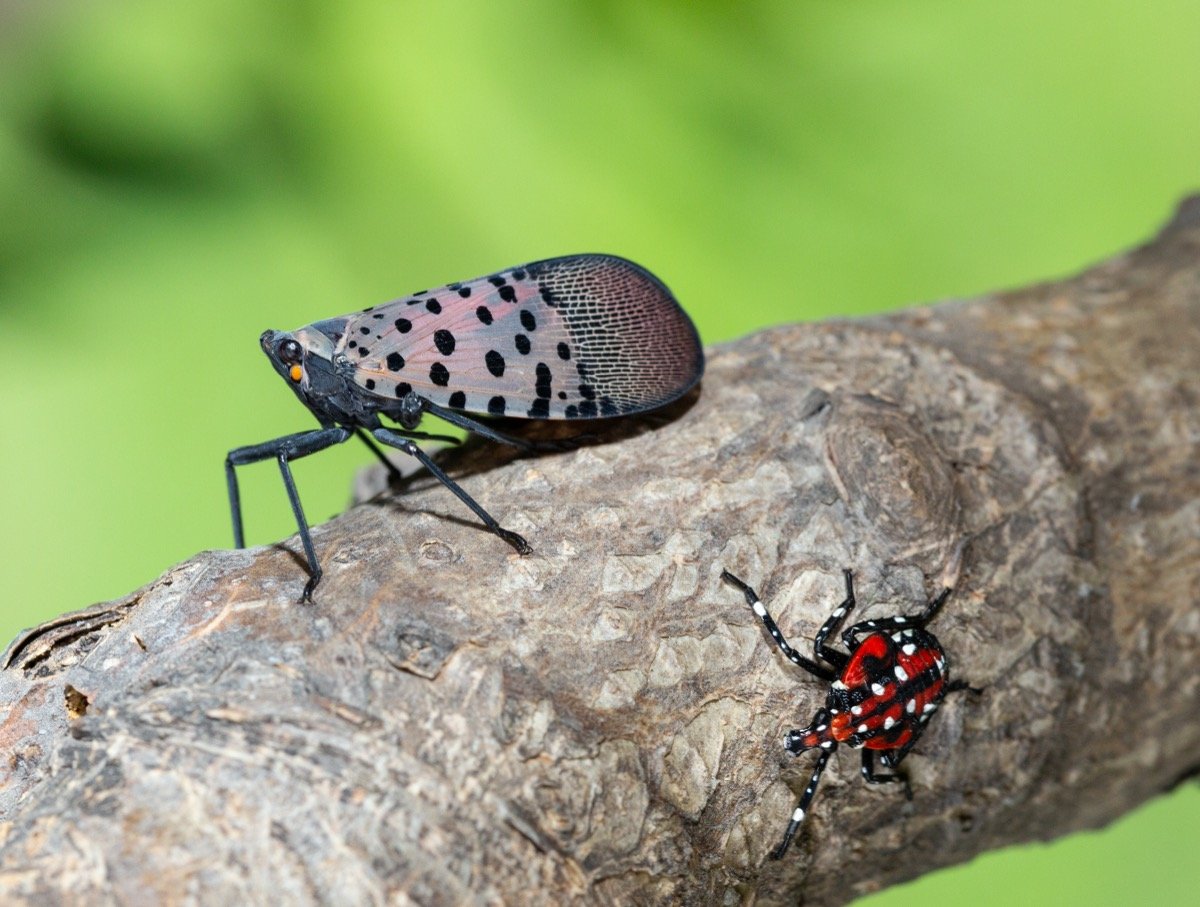
Spotted Lanternfly – Some Biology (before they come back)
Intro to SLF
The spotted lanternfly is an invasive insect that has recently made its way to the Mianus River Gorge and surrounding areas. Native to China, the spotted lanternfly was first discovered in the US in Pennsylvania in 2014, but was not detected at the Gorge until 2022. Just one year after their arrival, we are now seeing them throughout the preserve. Currently, the spotted lanternfly has been detected in at least 14 states, primarily in the north-east, but without preventative management, they are projected to establish populations in California by 2033.
Spread of SLF
Spotted lanternflies are part of a group of insects called planthoppers, which get their name from the way that they hop for quick transportation. Adults can only fly short distances between trees, but they still manage to spread to new areas, mostly thanks to humans. Adults tend to spread through hitchhiking on cars, but the bigger problem is the transportation of egg masses.
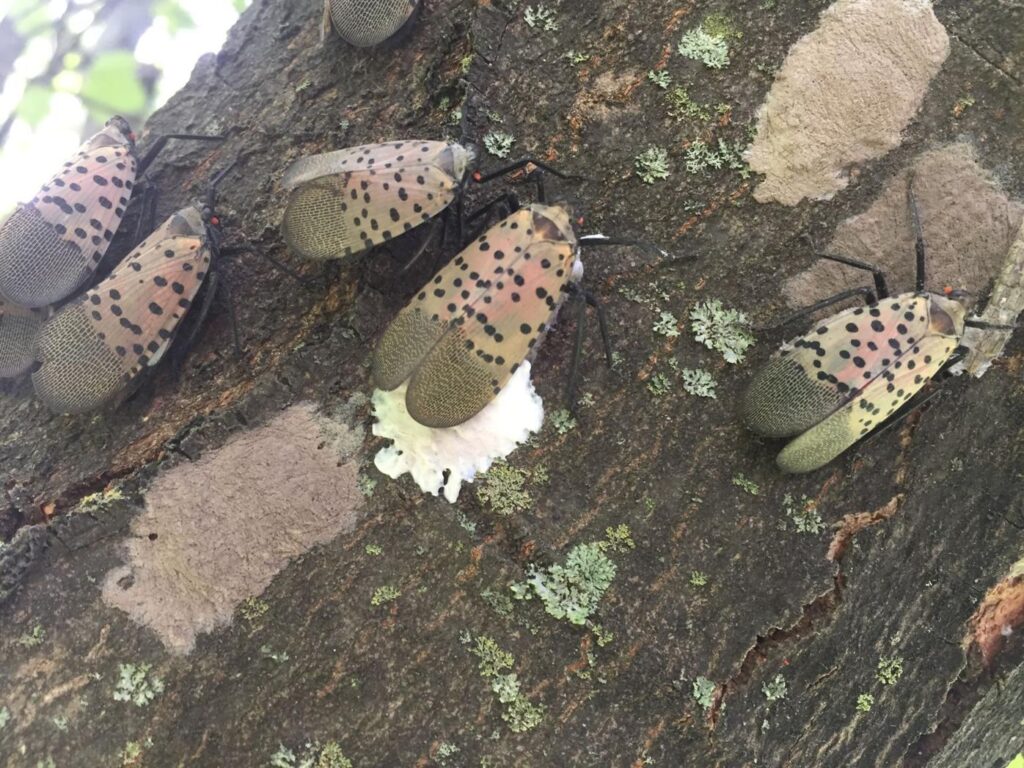
Each egg mass can contain up to 50 lanternfly eggs, and if multiple egg masses are accidentally transported, a new spotted lanternfly infestation is nearly inevitable. Egg masses are most often found on vehicles, firewood, outdoor furniture, and other similar items which are generally left outside for long periods of time. It is recommended to check one’s vehicle for possible hitchhikers when leaving any area with known spotted lanternfly infestations, and to be especially vigilant when transporting objects that could contain egg masses.
Biology of SLF
Spotted lanternflies hatch starting in April and continuing through June. During their early developmental stages, the spotted lanternfly nymphs are only about 1/8 – 1/4” long and are black with white spots. By July, the nymphs grow to about 3/4” long and turn red and black with white spots before they enter their final developmental stage. The nymphs soon develop into adults, which can be found from July through December. The adults are approximately 1” long, and are brown with black spots on their wings. Their abdomens, which are normally covered by their wings unless they are in flight, are bright red with black spots. By September, females lay at least two egg masses on hard surfaces as mentioned above. The adults die off in December, and the cycle starts again in May when the eggs hatch.
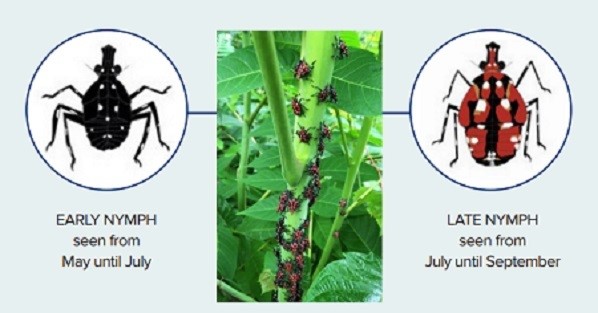
Spotted lanternflies are most often found on their preferred host, another invasive species called tree-of-heaven. It was originally brought over from China in the 1700s as an urban tree. Due to its rapid growth and ease of establishment, this tree has spread across the entire country and is now found in over 30 states. Tree-of-heaven is not shade tolerant. It is often seen growing along the highways or on forest edges, where it gets plenty of sun, but it can thrive in almost any disturbed area with enough soil to support saplings. The tree can even be found growing in cracks in the sidewalk or out of stone walls. Tree-of-heaven grows quickly and crowds out native species. It also releases chemicals into the surrounding soil that are toxic to other plant species.
While they are most often found on tree-of-heaven, spotted lanternflies feed on the sap of over 70 different species of plants. The nymph stages tend to feed on softer plant tissue, including many popular garden plants like cucumbers, basil, roses, and much more. The adults are able to feed on harder tissues and have a strong preference for the tree-of-heaven, but also frequently feed on grapevines. Grapevines seem to be their second favorite host, but it is unknown if they can sustain a population on grapevines alone.
As they feed, spotted lanternflies excrete a sticky, sugary substance called honeydew, which attracts bees, wasps, and other insects. In moderate to severe infestations, this honeydew can build up, dripping down off of the plants onto anything below. The honeydew promotes the growth of sooty mold, which, in heavier infestations, can cover leaves of understory plants, inhibiting photosynthesis. Excessive feeding by spotted lanternflies can cause significant stress to the plants, causing loss of productivity, or even kill the plant.
Another reason that the spread of spotted lanternflies is particularly concerning is because of the potential for severe impacts on several commercial crops, including grapes, apples, hops, and walnuts. Studies have been done to evaluate the impacts of spotted lanternflies on several of these crops. As expected, some are more heavily impacted than others. Grapevines are expected to be one of the hardest hit, with significant damage already being seen in Pennsylvania. In 2017, one Pennsylvania farmer reported a 90% loss in their grape yield and a loss in fruit quality due to an infestation of spotted lanternflies. Just two years later, in 2019, the vineyard showed a total loss of productivity. When combined with other environmental factors like climate change, even slight pressures on a crop can have significant consequences.
What can you do?
Here at the Gorge, we are employing several different methods to control spotted lanternfly populations.
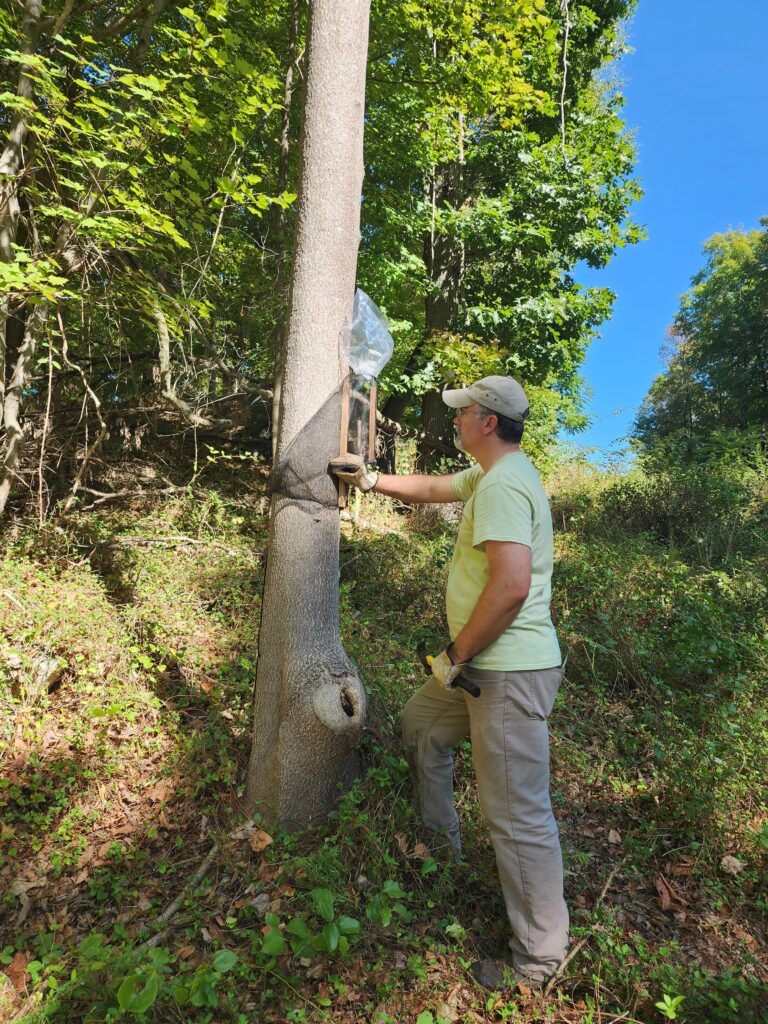
Vigilance – One of the best and easiest ways to stop the spread of the spotted lanternfly is simply to remain vigilant. When leaving an area with a spotted lanternfly infestation, check your vehicle and keep an eye out for any lanternflies that may have hitched a ride, both on the inside and outside of the vehicle. Check for egg masses on vehicles, garden tools, patio furniture, or anything else that gets left outside for extended periods of time.
Destroy egg masses – If you find spotted lanternfly egg masses on your property, you can destroy them either by crushing them or by scraping them into a container filled with rubbing alcohol or hand sanitizer.
Traps – There are two kinds of traps that are effective at catching spotted lanternflies. The first kind of trap involves wrapping a sticky band around the trunk of a tree (preferably tree-of-heaven). This method is effective, but can also catch other kinds of insects as well as birds and other creatures. If you do decide to use this method, it is recommended that you build a raised guard of wire or screening around the sticky band to prevent catching other animals.
The second kind of trap is called a circle trap. This trap is made from netting and a plastic bag. The netting is wrapped around the tree and funnels the spotted lanternflies into the bag. This trap is less likely to catch other insects or birds. These are the kinds of traps that we use at the Gorge to capture spotted lanternflies. You can see an example of these traps here – https://njaes.rutgers.edu/spotted-lanternfly/trapping.php
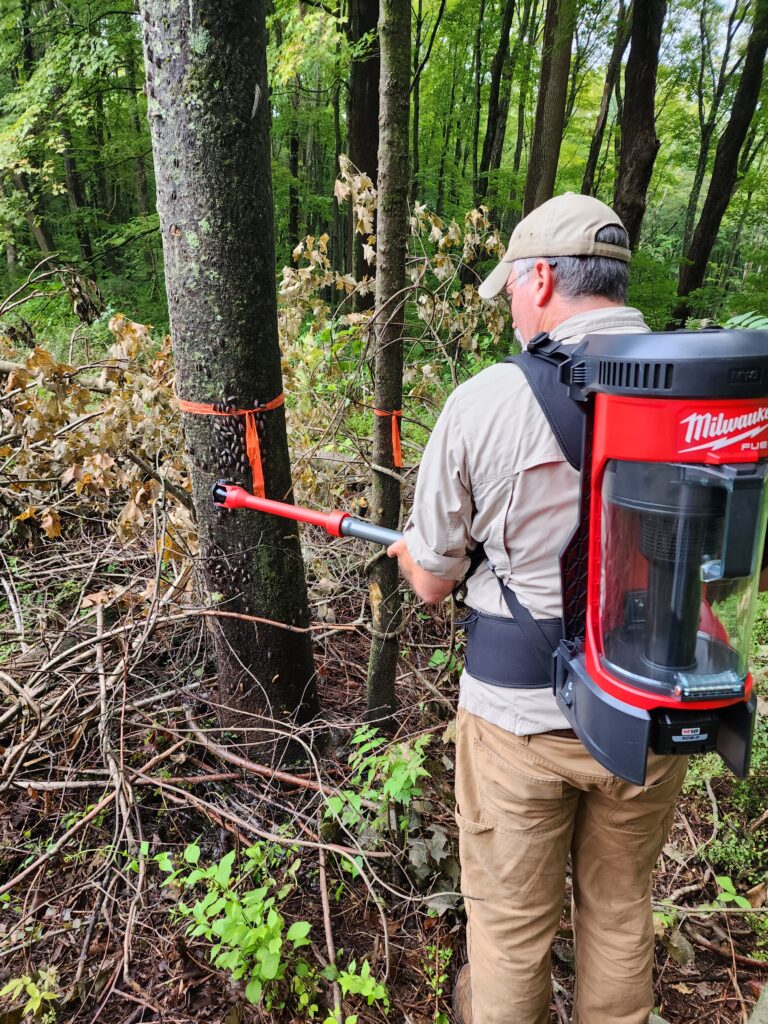
Vacuum – With heavier infestations, using a vacuum on the spotted lanternflies can also be an effective way to remove them. Shop vacs are very effective, as are battery powered, backpack vacuums. You can do this any time, but the most effective time to vacuum spotted lanternflies is right after it rains. The rain will wash the spotted lanternflies down the trunk of the tree into large masses, where they can be easily reached by a vacuum. Most of the lanternflies will die in the process, but there will likely be some survivors. You can either leave them in the vacuum for a day or two (they do not last long without food), or soak some cotton balls in isopropyl alcohol and put them into the vacuum for a few hours. Do not leave the spotted lanternflies in the vacuum for too long or they will start to rot, and the smell will not be pleasant. Make sure to clean your vacuum thoroughly after every use.
Remove tree-of-heaven – It is unknown if spotted lanternflies NEED tree-of-heaven to survive or if they just strongly prefer it, but either way, we are on a mission at the Gorge to remove every single tree-of-heaven from the preserve. This tree is incredibly invasive and is detrimental to the health and diversity of our forests, so even if we did not have a spotted lanternfly problem, we would still recommend trying to remove this tree from your property.
Removing tree-of-heaven is not as easy as it sounds, and if you are not careful you can very easily make the problem worse. Tree-of-heaven is remarkably resilient, and if it is cut down, it will send up hundreds of sprouts from the roots, sometimes as far as 50 feet away from the main trunk. Small seedlings can be pulled by hand (be sure to get the roots), but the root sprouts from an adult that was not properly killed are nearly impossible to pull effectively. To avoid this, herbicides must be used to kill the roots. Herbicides with the active ingredients triclopyr or glyphosate are recommended because they pose minimal risk to non-target plants through root uptake.
If you have tree-of-heaven on your property and would like more information about how to safely and effectively remove them, please refer to these resources:
https://extension.psu.edu/tree-of-heaven
For more information about the spotted lanternfly, you can click on the links below.
Citations
https://academic.oup.com/aesa/article/114/6/709/6358080
https://www.annualreviews.org/doi/full/10.1146/annurev-ento-120220-111140#_i2
https://extension.psu.edu/spotted-lanternfly-management-in-vineyards
https://www.nature.com/articles/s42003-022-03447-0
By Jean-Luc Plante, Mianus River Gorge Preserve Steward
